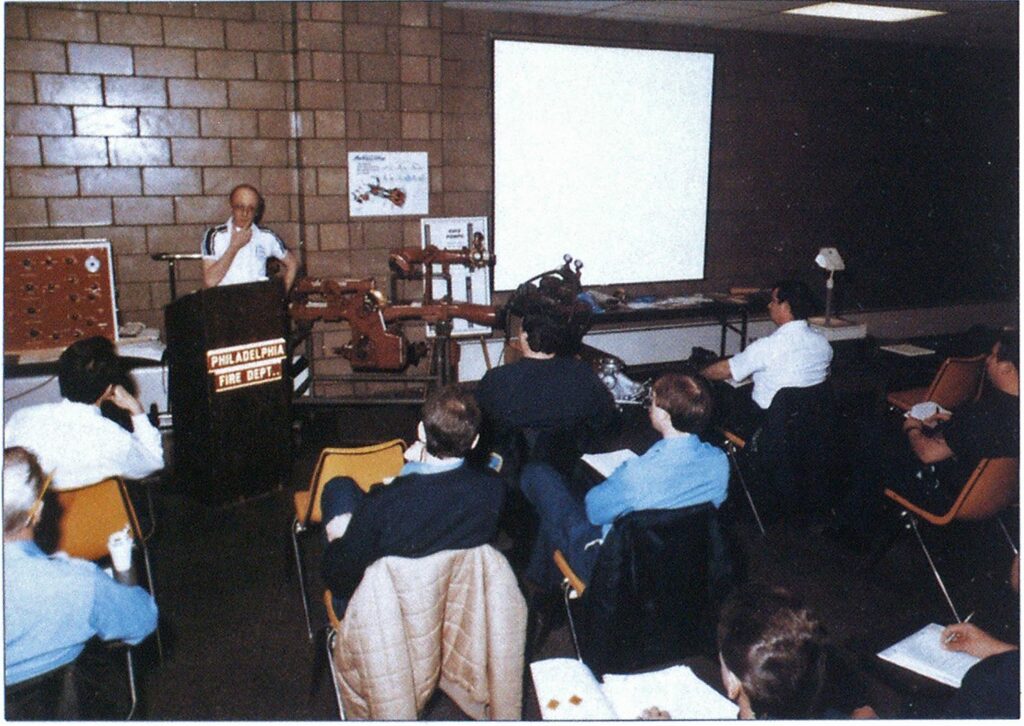
REFRESHER TRAINING
FEATURES
TRAINING
A Fresh Approach to

Photo by William Potoczny
Sometimes, the only thing standing between a “routine” fire and a multiple alarm with civilian and/or firefighter injuries or worse is well-executed, basic firefighting skills. And because of this, fire departments must constantly train their members to improve existing skills as well as test and develop new and better techniques.
Yet, unless dynamic and challenging to both the new recruit and the seasoned veteran alike, even the most thorough and informative training program will fall far short of being successful.
To meet its training needs and to peak the interest of its members, the staff of the Philadelphia, PA, Fire Department’s Fire Academy under the direction of Battalion Chief Joseph Barron, developed a new refresher training program (see chart). This five-day program replaces the department’s one-day “refresher” training program that engine and ladder companies attended on a rotating basis.
This new competency-based training program follows the guidelines of the National Fire Protection Association’s (NFPA) Standard 1001, covering specific areas of knowledge necessary to certify firefighters and fire officers to NFPA proficiency levels. The program exceeds the NFPA requirements for Fireman III and Officer I.
The refresher program also supplements the other two levels of training provided by the Philadelphia Fire Department: the intensive 11-week training course for new recruits, and the daily in-service training sessions at the company, battalion, and division levels.
“Our goal was to develop an informational course that was refreshing and basics oriented,” said Chief Barron. “We want to get back to the fundamentals, to start at point A, bring our people in, and make sure that they’re up to a skill level that they should be.
“There’s a good continuity for our students by having them come here for five days instead of the one-day session we used to have. Obviously, we can cover more information in five days, but, more important, if the student has questions about the day’s training, he’ll be back the next day and can get some answers. It develops a learning attitude that the one-day course lacked.”
The new refresher course is geared to intense classroom lecture and discussion periods plus ample hands-on training, enabling all students to get involved in practical evolutions. Seventeen different topics are covered during 25 sessions. Some topics, such as communications, are covered in one session, while others, such as pumps, take several sessions to cover thoroughly. The first two pump sessions are held in a classroom and review explanations and operations of a pump, relay pumping, and drafting. The third session is a practical session that covers the proper methods of pump testing with an actual pump test conducted.

Photo by William Potoczny
Several unique features in this training program include:
- Course attendance by fire personnel who are not members of the Philadelphia Fire Department;
- A session on stress management and the firefighter;
- Continuous analysis and updating of course material based on student evaluations.
For the first time in the department’s history, personnel from volunteer fire departments throughout the five-county suburban Philadelphia area have been invited to train alongside career personnel. In addition, members of industrial fire brigades, federal firefighters, and career firefighters from smaller departments also participate. Dispatchers from the Fire Communications Center are also sent for the training.
This open enrollment provides training and interaction among three main segments of the fire service (career, volunteer, and industrial). The exchange of ideas and the “we do it this way, you do it that way” comparison is extremely beneficial. All sides can learn with the shared experience.
Enrollment in each class is limited to 30 students, 20 from the Philadelphia Fire Department, and 10 from outside departments. A fee of $150 per student is charged for outside personnel.
Another feature of the new course is a session on stress management and the firefighter.
Stress is a recognized problem in the fire service and can account for physical as well as emotional problems. The staff of the fire academy assembled information covering several areas of stress management including recognizing what stress is, what can cause stress, how to recognize the various stressors, and how to deal with stress in your own life.
Finally, the new training program uses evaluations, suggestions, and comments by the students to adjust course content, delete unneeded material, and/or add information. For example, at one time in the program, a session was spent on supervision for the company officer or acting officer. A new 16-hour National Fire Academy course on supervision eliminated the need for inclusion of this topic in refresher training. Evaluations indicated that students wanted classes in fire tactics, so this replaced the supervision material.
Likewise, due to the student’s requests, classes on building construction and elevator extrication/ rescue have been substituted for two of the formerly five sessions on pumps. Student evaluations indicated that three pump classes were sufficient to cover the material.
The fire academy plans to present the new course 40 times a year, allowing a maximum of 800 Philadelphia Fire Department personnel and 400 outside fire personnel the opportunity to attend. All 2,500 members of the Philadelphia Fire Department will eventually attend this courseo.


